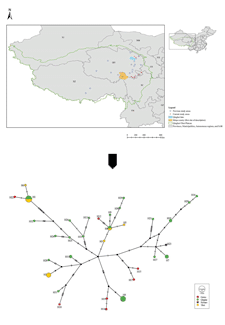Published online by Cambridge University Press: 24 March 2021

Echinococcus shiquicus is currently limited to the Qinghai–Tibet plateau, a large mountainous region in China. Although the zoonotic potential remains unknown, progress is being made on the distribution and intermediate host range. In this study, we report E. shiquicus within Gansu and Qinghai provinces in regions located not only around the central areas but also the southeast edge of the plateau and describe their genetic relationship with previous isolates from the plateau. From 1879 plateau pikas examined, 2.39% (95% CI 1.79–3.18) were infected with E. shiquicus. The highest prevalence of 10.26% (4.06–23.58) was recorded in Makehe town, Qinghai province. Overall the prevalence was marginally higher in Qinghai (2.5%, CI 1.82–3.43) than in Gansu (2%, CI 1.02–3.89). The cox1 and nad1 genes demonstrated high and low haplotype and nucleotide diversities, respectively. The median-joining network constructed by the cox1–nad1 gene sequences demonstrated a star-like configuration with a median vector (unsampled haplotype) occupying the centre of the network. No peculiar distinction or common haplotype was observed in isolates originating from the different provinces. The presence of E. shiquicus in regions of the southeast and northeast edges of the Qinghai–Tibet plateau and high genetic variation warrants more investigation into the haplotype distribution and genetic polymorphism by exploring more informative DNA regions of the mitochondrial genome to provide epidemiologically useful insight into the population structure of E. shiquicus across the plateau and its axis.